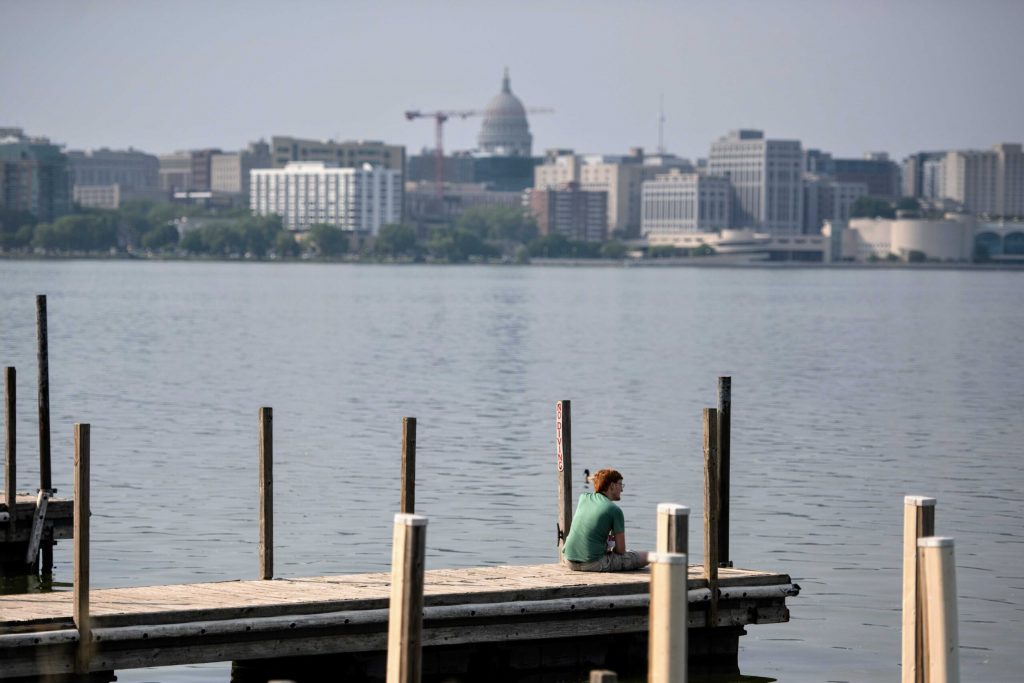Wisconsin Tourism Had Record-Breaking Year in 2024
New high of 114 million visits to state, $25.8 billion economic impact.

A man sits on a dock as smoke shades the view of the Wisconsin State Capitol across Lake Monona on Wednesday, June 4, 2025, in Madison, Wis. Angela Major/WPR
Wisconsin’s tourism industry experienced its third-straight year of record-setting economic impact in 2024 and set a new all-time high for the number of visits to the Badger State, Gov. Tony Evers announced Tuesday.
The state’s tourism industry generated $25.8 billion in total economic impact last year, beating the record set in 2023 of $25 billion, according to data from the state Department of Tourism.
On top of monetary impact, there were also a record 114.4 million visits to Wisconsin in 2024, beating the previous record of 113.2 million visits set in 2019, the department said.
“That number is built off of repeat visitors,” said Craig Trost, communications director for the Department of Tourism. “They are the backbone of our tourism economy.”
The agency, more commonly known as Travel Wisconsin, counts a visit as any trip a person takes that’s more than 50 miles from home, meaning the 114.4 million number includes Wisconsinites traveling between communities.
The visitor economy also generated $1.7 billion in state and local taxes, offsetting taxes for residents by $678 per household, according to a report from the tourism department.
In a statement, Evers called tourism a “critical industry” for Wisconsin’s economy and said he’s proud of its “record-breaking roll” over the last three years.
“I’m incredibly grateful for the strategic work of the Wisconsin Department of Tourism and the hardworking folks across the tourism industry who have helped put us in a strong position,” Evers said. “We’ve made smart investments in the growth of the industry because investing in tourism is an investment in our workers, our small businesses, and our local communities.”
The last two-year state budget included $34 million for the state Department of Tourism to promote Wisconsin as a destination.
Trost said that funding allowed the department to run marketing campaigns that helped it compete for visitors from other states.
“Those additional funds were absolutely critical in our ability to reach new visitors,” he said.
The tourism industry supported 182,000 part- and full-time jobs last year, an increase of 2.2 percent from 2023, according to the department.
Trost also said all 72 of Wisconsin’s counties, from urban to rural, play a role in Wisconsin’s tourism landscape.
Rural Adams County in central Wisconsin saw the largest percentage increase in economic impact from tourism last year, according to a spreadsheet from the state.
The economic impact of tourism in Adams County rose by 6.8 percent from $250 million in 2023 to $267 million in 2024. For comparison, statewide growth in tourism economic impact during that time period was 3.3 percent.
Megan Steckelberg, president and CEO of Visit Adams County, said her county has more than 20 lakes, making it a popular spot for outdoor recreation.
Besides activities on the water, visitors often come for rock climbing, riding ATVs and UTVs, visiting boutique shops and stopping in local restaurants, she said.
“That’s what people are drawn to,” she said of Adams County’s outdoor recreation. “They want to get away from the city. They want to get away from the big life and come here and just relax and enjoy life.”
Steckelberg said a lack of snow in the winter months has put a damper on offseason tourism in recent years.
While most counties did see their economic impact from tourism increase last year, several saw decreases, according to state data. Counties with declines in tourism economic impact include Ashland, Clark, Forest, Grant, Iowa, Iron, Juneau, Lafayette, Monroe, Taylor and Trempealeau.
Wisconsin tourism industry’s ‘record-breaking roll’ sets new highs for economic impact, visits was originally published by Wisconsin Public Radio.
If you think stories like this are important, become a member of Urban Milwaukee and help support real, independent journalism. Plus you get some cool added benefits.






















Yea, I wonder how tourism will be in 2025 under the leadership of President Bonespurs very advanced brain.
(from Forbes)…
“The United States is the only country among 184 global economies analyzed by the World Travel & Tourism Council and Oxford Economics that is poised to lose a staggering $12.5 billion in international visitor spending this year. It is a 22.5% decline compared to 2024 and the equivalent of California’s annual travel-related state and local tax revenue”.